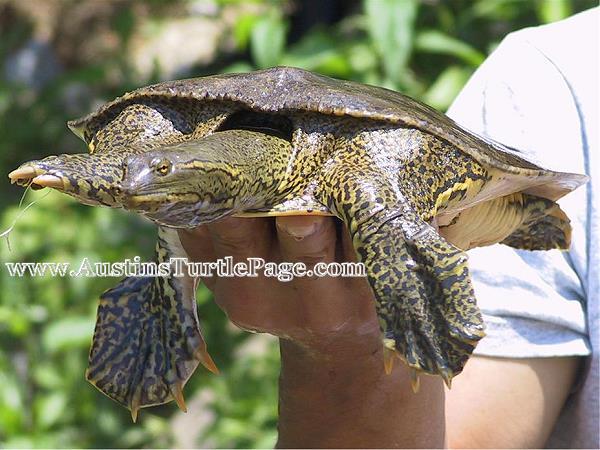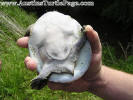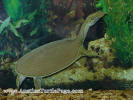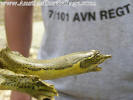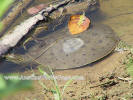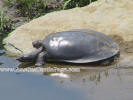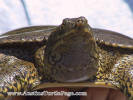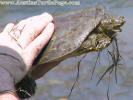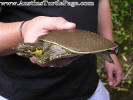|
|
|
|
|
Medium to very large turtles with a round (hatchling) to oval (adult) skin-covered flattened carapace without scutes or keeling. In the hand they feel something like wet leather. The carapace (which extends back a good deal further than in our basking species) is flexible, & the posterior lip hangs a bit in some adults. The head has fairly high-set eyes & a long, almost snorkel-like nose giving them a ‘needle-nose’ or ‘Pinnochio’ face. The head enjoys excellent mobility on the neck, & softies can rise up from underwater & set the head with eyes & nose just above the surface, like an alligator. The neck is unusually long & rather thick. Spiny softshells take their name from small ‘thorn-like’ spines at the anterior carapace, prominent in some adults but harder to detect in juveniles. The carapace & skin match in color; variably tan to muddy-brown to olive, with spots or ocelli prominent on juveniles & some males but less distinct in larger females. The adult carapace can have a strong mottled, ‘muddy’ patterning. There may be limited striping on the head & neck. Softshells can darken & lighten their color a great deal over time to better match their habitat. The underside of the shell is while (yellow in some); the undersides of the limbs may be lighter as well. The plastron is hinge-less & reduced compared to the carapace. The toes are clawed & prominently webbed, & the feet have an oar-like appearance. Large specimens can inflict severe scratches. Softshells (all species) stand out amongst North American turtles in having fleshy lips. In large adults this feature may be a bit exaggerated. Be warned - right behind those lips are hard, sharp jaws that can put you in stitches. A prominent distinguishing feature of spiny softshells is the presence of a nasal septum lateral ridge’ – a small ‘bump’ on either side of the septum extending slightly into the nostril (pictured above). This aids in distinguishing spiny from smooth softshells. However, Florida softshells also have this ridge & Guadalupe spiny softshells may not (per Tom C. & Snapper Greg). Florida softshells lack anterior carapacial spines but have blunt knob-like bumps instead. Male spiny softshells have larger, longer tails with the anus near the tip & are more prone to retain the vivid coloration & patterning of juveniles. They lack the elongated fore-claws typical of male sliders & cooters. Females get much larger than males. We must emphasize that females can get massive by hobbyist standards. Males are hardly ‘small,’ but large females of this alert, active species are challenging to house. You must see a large female to appreciate this. Overall Distribution: The 6 U.S. occurring sub-species: South-Central & South-Eastern U.S., with some branching & isolated populations in the southwest. There’s a disconnected group covering part of Montana. Strangely in the eastern states north of South Caroline (NC, VA, MD, DE, NJ) they are either absent or restricted to the western edges (& southern NC). NY & Vermont have some. Spiny softshells do penetrate slightly into extreme southeastern Canada. Adult Sizes: Male 5" - 9½" Female 6½" – 18" |
||
|
|
|
|
|
|
|
||||||||||||||||||||||||||||||||||||||||||||||||||||||||||||||||||||||
|
||||||||||||||||||||||||||||||||||||||||||||||||||||||||||||||||||||||||
|
|
|
|||||||||||||||||||||||||||||||||||||||||||||||||||||||||||||||||||||||
|
|
|
|
||||||||
|
TEMPERATURE RANGE (°F)
Softshell keepers should have a solid understanding of water quality, filtration, cover & substrate issues, coupled with the resources to provide spacious enclosures. CAPTIVE DIET In the wild, they are predominant carnivores utilizing a wide prey-base varied with availability, including insects & insect larvae, crayfish & other crustaceans, small fish (live), larger fish (carrion), snails, mussels, frogs and worms. Some take in some vegetation. Don’t over-generalize from single locale population studies, but do consider Turtles of the United States and Canada1 Page 122-cited research (Williams & Christiansen, 1981)2 on the diet of spiny softies in Iowa – 36.5% fish (likely carrion), 5.8% small fish (likely caught) & 55% crayfish; 61% of spinies sampled contained plant matter. The % by volume was 24.2% crayfish, 17.2% large fish (remember; likely carrion), 2.2% small fish, 12.8% plant matter, & 21.6% as insects/insect larvae (i.e.: mayflies, beetles, Hemipterans ‘true bugs,’ dragon flies & damsel flies, caddisflies & some unidentifiable insect material), 19.5% unidentified animal matter & 2.0% sand &/or gravel. Also cited is research by Breckenridge (1944)3 on 18 spinies in Minnesota who contained 44% crayfish, 29% aquatic insects & 8% fish. So in nature the diet is overwhelmingly small invertebrates (insects & crayfish) supplemented with small fish, fish carrion & other items (i.e.: snails & mussels). Spiny softshells actively hunt but also ambush prey. In captivity spiny softshells tend to favor carnivorous food items like aquatic turtle pellets, grasshoppers, crickets, ghost shrimp, small crayfish, small fish, earth worms & blood worms. They may show little interest in aquatic plants or Romaine lettuce but will eat Spirulina algae wafers & commercial tortoise pellets. A youngster may be slow to warm to commercial pellets. We recommend you don’t use wild snails (known to be intermediate vectors of a number of indirect life cycle parasites affecting a range of animals, & snails of the genus Goniobasis are known to transmit lung flukes to loggerhead musk turtles5). If you don’t provide UV-B lighting, make sure the diet includes Vitamin D3 sources such as a brand name commercial food (i.e.: ReptoMin or Mazuri aquatic turtle foods). RECOMMENDED FEEDING SCHEDULE For the first 6 months of life, feed commercial pellets or meaty foods such as earthworms or fish in moderation once daily, enough to diminish appetite but not gorge the turtle. After 6 months, switch to every other daily feeding. Romaine lettuce & other leafy greens may be offered daily for graze at will (if your softy is an odd-ball & likes plants). Over time adjust diet content & schedule accounting for growth, activity level & appetite. Overfeeding high-protein foods can cause rapid growth & is believed harmful to the liver & kidneys. Softshells lack the keratinized plates (scutes) of hard-shelled species & I’ve not heard of shell deformities (pyramiding) from over-feeding as basking turtles may suffer, but they can still suffer metabolic bone disease (MBD) like any reptile. It is critical you do not gorge your juvenile softshell. We have had reports of both smooth & spiny softshell juveniles abruptly dying shortly after gorging on food. The mechanism is unknown (Timdog speculated so much food may cause a drop in abdominal space preventing lung expansion, but we don’t know). CAPTIVE HABITAT Wild softshells are heavily aquatic & seldom leave the water except to lay eggs or bask (they are at serious risk for dehydration if out of water long). Turtles of the United States & Canada1 Pages 117-118 claims they are predominantly a riverine species (also inhabiting marshy creeks, bayous, oxbows, lakes & impoundments), & states a soft bottom with some aquatic vegetation seems essential (& sandbars & mud flats are usually present). The Amphibians and Reptiles of Arkansas6 Page 241 states they inhabit a wider variety of habitats, & are more prone to bask on emergent rocks, logs & other objects, than smooth softshells. Turtles of the United States & Canada1 also states the preferred microhabitat appears dominated by areas with much submerged brush, fallen trees & other debris. I found an adult in a creek under 10 feet wide, & many live in our neighboring Little River in SW KY, including area around 20-30 feet wide & 1-3 feet deep. I can view the most wild Eastern spiny softshells in large stream-like habitat with steep, grassy but not badly overgrown banks & good sun exposure. I have not found the lack of brush & debris to be a problem. They bask on muddy banks at the water’s edge, often right on the water line, facing the water & ready to dart in. Rocks & even logs may be used. Wild spiny softshells are vigilant & wary, quick to slide in when humans are still many yards away (as befits an animal with no hard-shelled protection). Unlike with sliders, field herping spiny softshells is an acquired skill. One common feature of spiny softshell habitats seems to be moving (hence better oxygenated) water; I’ve seen them in creeks & rivers but not static water bodies like farm ponds. Turtles of the United States & Canada1 Pages 118-119 indicates they’re strongly diurnal & at night sleep buried in bottom substrate or amid branches of submerged trees. In southwestern KY Wallob & I have noted softshells are the last aquatic turtles to come out in Spring & the first to disappear in the Fall (compared to RES, stinkpots & common snappers). In captivity, spiny softshells need spacious enclosures with pristine water quality, cover to feel secure (such as live or plastic plants) & a basking platform. They are apt to burrow into sand or muddy bottoms, & given the chance may extend the neck up for air without coming out (looks rather like a very strange needle-nosed snake). ‘Play Sand’ (sold at Home Depot & other vendors) is widely used for softshells. Sand sucked into your filter’s intake can damage the impeller, so if you use sand keep the intake at least 5” above the sand bed & ideally put a pre-filter sponge on your intake. Small gravel is an alternative less prone to get sucked into filters but your Python or gravel vacuum will suck it up more so than larger gravel. Some keepers compromise & offer a bowl or basin of sand in the tank; be warned it’ll get out! For no substrate or non-burrowable substrate tanks, supporting cover is important; aim for a ‘jungle look’ with submerged plastic &/or live plants. Softshells are vulnerable to bacterial & fungal infections starting with scratches & nicks from tank contents or other turtles; hence, avoid abrasive tank contents, crowding & poor water quality. If your animal seems infection-prone consider a UV-Sterilizer. Their burrowing may uproot plants; consider such plants as Anacharis or some Salvinia that require no substrate. In deference to their natural flowing, well-aerated habitat, direct your filter’s outflow to provide surface flow/turbulence. In Keeping and Breeding Freshwater Turtles7 Page 127, Russ Gurley indicated adding 1 teaspoon aquarium salt per gallon water can be beneficial. Someone reported keeping softshells in outdoor concrete ponds where they prospered & speculated that natural sunlight may’ve enabled them to shrug off the nicks & scratches concrete brings. I don’t recommend concrete or brick in softy tanks, but be aware. If you must use concrete, consider sealing it with something like marine epoxy, which coats & smooths. RECOMMENDED ENCLOSURE Recommended size for a single adult Apalone spinifera would be a 75 gallon aquarium as a minimum (90 or larger preferred) for a male. We don’t recommended large females be kept in conventional aquariums. They are too large & active and require extreme amounts of space. Stock tanks are an option, with a minimum requirement of 400 gallons (600 gallon or larger preferred). This will provide adequate swimming space & assist the filtration in maintaining good water quality. For additional males, we recommend adding a minimum 75 gallons of tank space per additional turtle. For females, add no less than 100 gallons of space per turtle. With these space recommendations you may consider a swimming pool. Be sure you get one with great structural stability. WATER DEPTH At least 1.25x’s the SCL of an adult, & preferably deeper, up to 4 feet or more. A shallow ‘shelf’ area for resting near the surface will be appreciated, particularly if it offers a container of sand to burrow in. COMMUNITY HABITAT Turtles of the United States & Canada1 Page 120 states spiny softshells are aggressive toward their own species, the larger tend to dominate the smaller in captive interactions (invariably involving a considerable amount of biting) & yet they’re usually not pugnacious with hard-shelled turtles. In Keeping and Breeding Freshwater Turtles7 Page 127, Russ Gurley notes they are somewhat aggressive, especially to smaller softshelled turtles. Bill Ninesling of Indian River Reptile, Inc. once told me they’re often tail nippers. Tom noted there have been those that have had success keeping them with Musk Turtles, Sliders, Cooters, Map Turtles and Painted Turtles. He has kept 2 separate male spiny softshells with hard-shelled tank mates (but not each other) without problems. Some people do mix them. Visual barriers in large tanks may help but no home aquarium is large enough to thwart a determined aggressor. Softshells’ thin noses are vulnerable to fights over food, & the slim, soft shells are easily injured. Such injuries are infection-prone. We recommend keeping softies alone or in spacious enclosures with strong filtration, no crowding & no aggressive tank mates. Watch closely when first mixing. |
||||||||||
|
|
|
|
|
|
|
|
Unlike many of their hard-shelled brethren, spiny soft-shell turtles do not exhibit temperature-dependent sex determination & clutches will produce roughly 50/50 mixes under a range of conditions. Females are large enough to lay large clutches. Keeping and Breeding Freshwater Turtles7 Page 272 gives typical artificial incubation time at around 55-60 days at 82ºF & 75-85% humidity. Considering that spiny softshells have large clutches, are demanding to keep long-term, neither threatened nor endangered, in good supply in the hobby, & command low prices, it is not recommended you breed them. Hatchlings softshells are delicate; in Keeping and Breeding Freshwater Turtles7 Page 126, Russ Gurley opines they are probably the most sensitive hatchling turtles in captivity re: captive care. In Practical Encyclopedia of Keeping and Breeding Tortoises and Freshwater Turtles9 Page 256 A. C. Highfield recommended both high quality external filtration & UV sterilization to reduce risk of slight injuries becoming infected. Keeping wastes dilute & filtration strong is easiest in large water volumes. While a 20 gallon long tank 2/3’rds filled is acceptable, the larger the tank the better water quality is apt to be. Provide real (if you have strong lighting) or artificial plants for cover, & ideally either a sand substrate or bowl of sand for hiding to foster a sense of security. Aim for water temp. 80ºF & offer a non-abrasive basking platform. UV-B lighting is recommended. If you have more than one in an enclosure, watch for aggression, injuries & avoid over-feeding. We recommend a UV sterilizer at least on smaller enclosures or those with a number of turtles. |
||
|
|
|
|
|
|
|
|
Spiny Softshell turtles can be aggressive when handled. Larger specimens’ jaws can lacerate you badly enough to require stitches, & their claws can on occasion penetrate skin. They have a long reach & often struggle vigorously when handled. The 6 spiny softshell sub-species native to the U.S.A. range from neotropically warm extreme southern US & even northern Mexico all the way to extreme southeastern Canada. Don’t expect a Texas softshell from northern Mexico to handle overwintering in the harsh climate of Montana! Be mindful of sub-species & ‘climate of origin’ if outdoor keeping is expected (with females, it always is). Turtles of the United States & Canada1 Page 119 cites research (Bentley and Schmidt-Nielsen, 1970)4 that spiny softshells’ skin is 3 or 4 times more permeable to water than sliders.’ Be mindful of that if you need dry dock one, or it escapes its enclosure. I don’t see spiny softshells wandering on land the way I see common snappers & RES do. Keeping and Breeding Freshwater Turtles7 Page2 124-125, Russ Gurley states successfully keeping softshells is very difficult & recommends keepers keep Acriflavine & Silvadene cream on hand for emergencies. Softshells are more sensitive to Betadine than hard-shelled turtles. You can treat some conditions with it, but don’t overdo it. It is possible to sex young juvenile spiny
softshells, albeit a few months after hatching. Hatchling spiny softshells (both
sexes) typically have prominent spots & ocelli (rings around spots). In females
over time the rings disperse to become smudgy halos, then continue dispersion to
form muddy patches/blotches reminiscent of lichen patches on a rock. Hatchlings
are roughly 30-40 mm SCL1. Terry Graham10 reported
examining about 60 Eastern Spiny hatchlings in Vermont with none displaying a
blotched (female) pattern. In a head-start program he later observed 6 Eastern
Spiny hatchlings over 4 months, & 2 developed female patterning (the first
indication being the smudgy halo around each ocellus) at around SCL 52 mm (a bit
> 2”). Regarding the Gulf Coast Spiny Softshell, Webb11 cited the
largest females with no blotched pattern were PL (plastron length) 7.6 cm & 8.0
cm (SCL would’ve been a bit longer). In summary, while this method is not
full-proof, for juvenile Eastern spiny softshells > 2” SCL well-defined rings/ocelli
with no smudging appear strongly suggestive of males, whereas ring-smudging &
blotchiness is strongly suggestive of a female. BIBLIOGRAPHY
1.) Turtles of the United States and Canada – Carl H. Ernst, Jeffrey E. Lovich and Roger W. Barbour. Smithsonian Institution Press, Washington and London. ©1994. (Possibly the preeminent natural history text of North American turtles – very highly recommended. Note it uses an older naming system for North American soft-shells). 682 pp. 2.) Williams, T. A., and J. L. Christiansen. 1981. The niches of two sympatric softshell turtles, Trionyx muticus and Trionyx spiniferus, in Iowa. J. Herpetol. 15:303-308 ((cited in Turtles of the United States and Canada, Page 122). 3.) Breckenridge, W. J. 1944. Reptiles and amphibians of Minnesota. Univ. Minnesota Press, Minneapolis. 202 pp. ((cited in Turtles of the United States and Canada, Page 122). 4.) Bentley, P. J., and K. Schmidt-Nielsen. 1970. Comparison of the water exchange in two aquatic turtles, Trionyx spinifer and Pseudemys scripta. Comp. Bio-chem. Physiol. 32:363-365 (cited in Turtles of the United States and Canada, Page 119). 5.) Cox, W. A., S. T. Wyatt, W. E. Wilhelm, and K. R. Marion. 1988. Infection of the turtle, Sternotherus minor, by the lung fluke, Heronimus mollis: incidence of infection and correlations to host life history and ecology in a Florida spring. J. Herpetol. 22:488-490 (cited in Turtles of the United States and Canada, Page 160). 6.) The Amphibians and Reptiles of Arkansas – Stanley E. Trauth, Henry W. Robison and Michael V. Plummer. University of Arkansas Press. © 2004. (Billed as the product of 15 years of work by top herpetologists, features over 136 species & sub-species). 7.) Keeping and Breeding Freshwater Turtles Russ Gurley. Living Art Publishing, Ada, Oklahoma. ©2003. (Excellent advanced general care guide). 300 pp. 8.) Reptiles and Amphibians of Eastern/Central North America – Peterson’s Field Guide Series – Roger Conant and Joseph T. Collins. 3’rd Ed., expanded. Houghton Mifflin Company, Boston, New York. ©1998. 9.) Practical Encyclopedia of Keeping and Breeding Tortoises and Freshwater Turtles – A. C. Highfield. Carapace Press, London, England. ©1996. (The definitive general chelonian husbandry guide for years; the only serious competitor I’ve seen is Gurley’s book1). 10.) Graham, T. E. and C. B. Cobb. 1998. Sexual dimorphism of neonate eastern spiny softshells, Apalone spinifera. Chelonian Cons.Biol. 3:111-112. 11.) Webb 1992. Univ. Kansas Publ. Mus. Nat. Hist. 13:429-611). |
||
|
|
|
